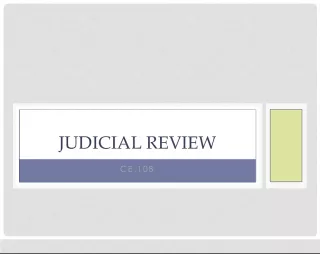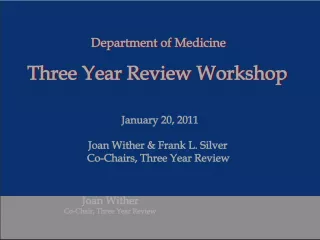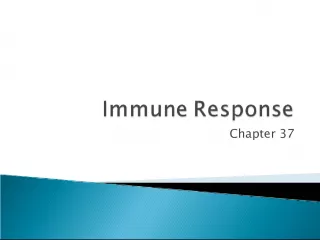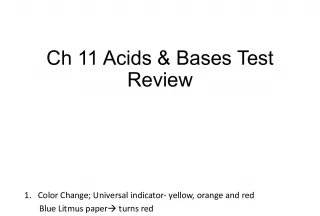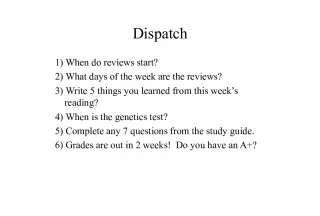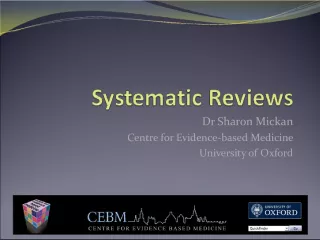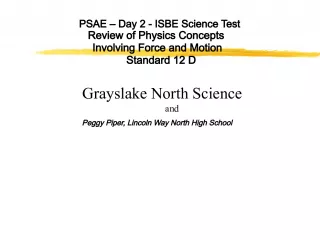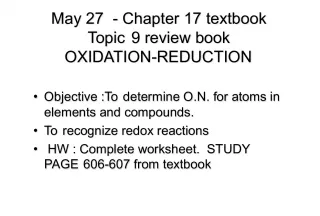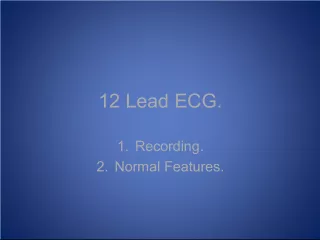Nocardia: A Review of the Pathogen
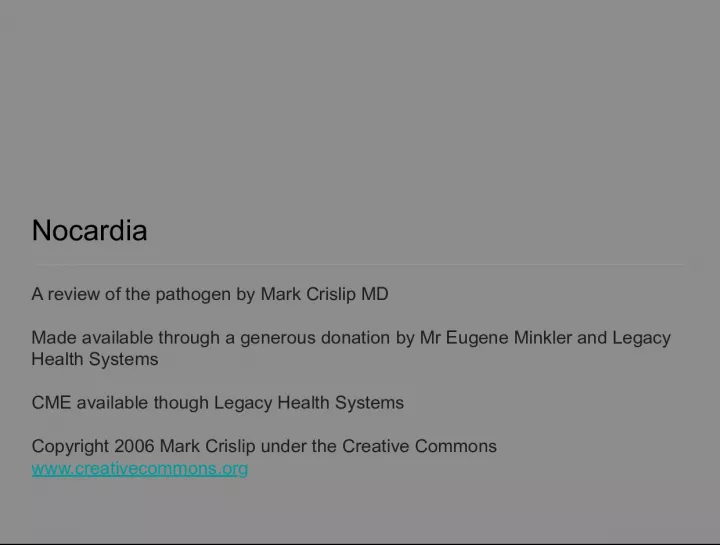

This article is a review of the pathogen Nocardia, a gram-positive bacteria that has branching filamentous cells. It includes its classification, history, and relation to other bacteria in the subgroup. CME is available through Legacy Health Systems.
- Uploaded on | 0 Views
-
 gwendlyn
gwendlyn
About Nocardia: A Review of the Pathogen
PowerPoint presentation about 'Nocardia: A Review of the Pathogen'. This presentation describes the topic on This article is a review of the pathogen Nocardia, a gram-positive bacteria that has branching filamentous cells. It includes its classification, history, and relation to other bacteria in the subgroup. CME is available through Legacy Health Systems.. The key topics included in this slideshow are Nocardia, Pathogen, Gram-Positive, Bacteria, CME,. Download this presentation absolutely free.
Presentation Transcript
1. Nocardia A review of the pathogen by Mark Crislip MD Made available through a generous donation by Mr Eugene Minkler and Legacy Health Systems CME available though Legacy Health Systems Copyright 2006 Mark Crislip under the Creative Commons www.creativecommons.org
2. History Named after Edmond Nocard, in 1888 described the organism in cattle with bovine farcy. First human case of nocardiosis was reported in 1890 by Eppinger.
3. Classification gram-positive bacteria. on microscopy have branching filamentous cells. Members of the group are often only distantly related phylogenetically. Part of a subgroup, the aerobic nocardiform actinomycetes that includes Mycobacterium, Corynebacterium, Nocardia, Rhodococcus, Gordona, and Tsukamurella and the cause of Whipple's disease (Tropheryma whippeli).
4. Classification standard laboratory techniques are limited in their ability to differentiate these organisms. molecular genetics have identified at least 30 species, 13 of which cause human infection. The more common human pathogen are Nocardia asteroides sensu stricto, Nocardia farcinica, Nocardia nova, Nocardia brasiliensis, Nocardia pseudobrasiliensis, Nocardia otitidiscaviarum, and Nocardia transvalensis. Rarer human pathogens include but are not limited to Nocardia abscessus, Nocardia africana ,Nocardia cyriacigeorgica, Nocardia paucivarans, and Nocardia veterana. A medline will reveal many others.
5. Epidemiology Nocardia is everywhere in the environment: soil, organic matter, and water. Human infection usually occurs from minor trauma and direct inoculation of the skin or soft tissues or by inhalation. It is also a common animal infection Outbreaks in oncology and transplant wards and surgical wounds have occurred from fomites, hospital construction with resultant contaminated dust, and health care worker hands.
6. Microbiology Branching, beaded, filamentous bacteria Can cause "Sulfur granules" like actinomycosis, in nocardial mycetomas. stains acid fast in tissue unlike the Actinomyces.
7. Picture of Nocarida from: www.englewoodgov.org/home/index.asp ?page=187
8. Virulence Factors Virulent strains are relatively resistant to neutrophil-mediated killing. organisms in the logarithmic growth phase are more toxic to macrophages. inhibit phagosome-lysosome fusion more successfully in vitro, which gives rise to L-forms, which can survive in macrophages for days L-forms have been found human and animal infections and perhaps account for treatment failure. L forms, as you may remember, are cell wall deficient organisms
9. Virulence Factors the inability to be killed my normal white cells takes on additional significance in the immunoincompetant who have WBC dysfunction that tips the battle between host and pathogen in favor of the Nocardia. Patients with CGD have increased risk for Nocardia infections, a double whammy where the patients cannot generate an oxidative burst and some strains have the ability to make superoxide dismutase,
10. Virulence Factors there are species tissue tropism's: N. asteroides complex including N. farcinica cause 80% of noncutaneous invasive disease and for most systemic and CNS disease. N. brasiliensis: cutaneous and lymphocutaneous disease. N. pseudobrasiliensis: systemic infections, including the CNS. N. transvalensis and N. otitidiscavarium: Noncutaneous disease
11. Diagnosis let the lab know you are looking for Nocardia or it can be missed. Stains show gram-positive, beaded, branching filaments, that are usually acid fast. Standard blood culture media will growth of Nocardia organisms, but prolonged incubation (2 weeks) and blind subcultures may be required for their detection; Bacteremia is rare except in central venous catheter infection. Nocardia spp. will grow on most nonselective media used routinely for culture of bacteria, fungi, and mycobacteria but....
12. Diagnosis specimens with mixed flora can over grow the nocardia colonies Selective media may increase yield: Thayer-Martin agar with antibiotics paraffin agar. Buffered charcoal-yeast extract (BCYE) medium Decontamination methods used for mycobacterial culture kill Nocardia and may decrease culture yield.
13. Diagnosis Slow growing, Nocardia may take from 48 hours to several weeks. typical colonies are buff or pigmented waxy cerebriform colonies and/or as chalky white and are usually seen from 3 to 5 days. biochemical testing and antibiotic resistance patterns can differentiate some species, but PCR83,84 and 16S rRNA sequencing are the most reliable for giving a precise spp.
14. Risk Factors Immunocompromise: 60% of all reported nocardiosis is associated with preexisting immune dysfunction. organ transplantation, hematologic malignancy, alcoholism, steroid use, diabetes, acquired immunodeficiency syndrome (AIDS). Patients with chronic pulmonary disorders, especially, pulmonary alveolar proteinosis, Given its ubiquity in the environment and the increasing numbers of poor hosts, this organism should become increasingly common.
15. Clinical Syndromes: mucocutaneous can occur after minor trauma and animal or insect bites; may also colonize open wounds. Often in normal hosts. Misdiagnosis common. N. brasiliensis commonly causes a progressive cutaneous and lymphocutaneous (sporotrichoid) disease. presents as an ascending nodules N. asteroides more commonly causes self-limited infection.
16. Clinical Syndromes: mucocutaneous Mycetoma: a chronic progressive, destructive disease, occurring days to months after inoculation located distally on the limbs (classically the foot) and presents with Suppurative granulomata progressive fibrosis and necrosis sinus formation and destruction of adjacent structures, macroscopically visible infective granules Mimics fungal mycetoma and actinomycetomata (due to actinomycete).
17. Clinical Syndromes: pulmonary Pulmonary disease most common reported presentation; can colonize sputum of COPD patients but be wary of dismissing it 40% of reported cases; 90% are N. asteroides complex. Usually indolent and progressive; frequently spreads to CNS Suspect Nocardia if spread to contiguous structures, especially with soft tissue swellings or external fistulas, and spread to the CNS DDx includes mycobacteria, Actinomyces spp.) and fungal such as Cryptococcus neoformans, Aspergillus spp.
18. Clinical Syndromes: pulmonary Clinical Presentations: endobronchial inflammatory masses pneumonia lung abscess, cavitary disease empyema pneumonia (often progressive in HIV) it can invade through surrounding tissues like actinomycosis
19. Clinical Syndromes: pulmonary Radiologic manifestations include irregular nodules (often cavitating if large), reticulonodular, diffuse pneumonic infiltrates, pleural effusions. The "halo sign," a manifestation of aspergillosis in neutropenic patients, can occur been described. Progressive fibrotic disease may develop following inadequate therapy.
20. Clinical Syndromes: pulmonary Case of BOOP Progressive steroids due to progressive pulmonary infiltrates. Seized. Had multiple brain abscess that grew Nocardia. Treatment cured the brain abscess AND cured his so called BOOP, which was Nocardia all along.
21. Clinical Syndromes: CNS CNS involvement in 44% of cases of systemic nocardiosis 25% of reported nocardial disease other than mycetoma involves the CNS 50% involving the CNS alone. classic signs and symptoms of pyogenic infections absent indolent presentations lead to a diagnosis of cancer the usual cancer treatment of steroids NOT beneficial
22. Clinical Syndrome: other Eye: can be hematogenous or due to eye trauma Disseminated infections from central lines Other organs are reported and rare.
23. Clinical Syndrome: other all organs have been reported to be involved, the details are a medline a way.
24. Treatment I&D depending of the location reversal of immunosuppression sulfas the mainstay of therapy, but susceptibilities vary; for example N. farcinica usually resistant to third generation cephalosporins sulfonamide mono therapy in immunoin competent or severe disease has a 50% mortality rate in vitro sensitivity and resistance does not predict in vivo response send for susceptibility testing is reasonable
25. Treatment From Mandel et al The Principals and Practice of Infectious disease From Mandel et al The Principals and Practice of Infectious disease Copyright 2006 Elsevier
26. Treatment For severely ill patients and those with CNS disease involvement or dissemination, and in immunosuppressed patients use two or more drugs: TMP/sulfa PLUS amikacin and a carbapenem OR third-generation cephalosporin which can provide synergistic activity. Sulfonamides are the treatment of choice for N. brasiliensis, N. asteroides complex, N. transvalensis. Linazolid looks particularly interesting in vitro. Oral alternatives to TMP/sulfa include minocycline and amoxicillan/clavulanate
27. Treatment For uncomplicated cutaneous disease 5 mg/kg/day of TMP/Sulfa (Bactrim, Septa, Cotrim) CNS and severe or disseminated disease should be treated with 15-20 mg/kg/day in divided doses, plus standard doses of amikacin and beta lactam
28. Treatment: duration Expect a clinical response in 3 - 10 days Duration is until cure. Often 3-6 months total, after 2 month can be changed to po Cutaneous disease usually is cured in a month or two Non CNS disease is usually treated for 6 months; CNS disease is treated for a year. Relapses can occur up to a year after stopping therapy; AIDS patient and perhaps other immuno incompetent should be maintained on lifelong suppressive TMP/SULFA
29. Outcomes Cure rates of almost 100% are found in patients with skin or soft tissue disease 90% in pleuropulmonary disease 63% in disseminated infection 30- 50% in brain abscess. the longer the delay in diagnosis, the more extensive the disease and the worse the immunosuppression, the worse the outcome
30. The End A review of Nocardia by Mark Crislip MD Made available through a generous donation by Mr Eugene Minkler and Legacy Health Systems CME available though Legacy Health Systems Copyright 2006 Mark Crislip under the Creative Commons www.creativecommons.org For more Infectious Disease podcasts go to www.pusware.com
